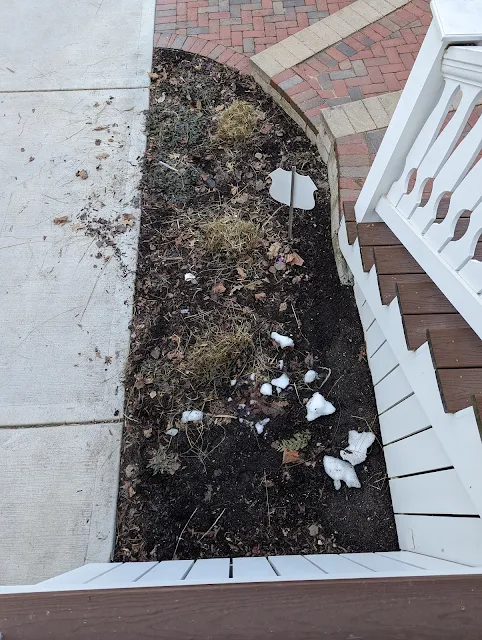Cleaning Up Front Porch Beds - Ornamental Grasses for Compost - February 2024
A couple of days ago, I posted in my [compost bins] diary a look at the current state of my bins now that I've topped them off with a lot of ornamental grass material - reeds, canes and blades. I tried to chop the material down into smaller segments in an attempt to break it up a bit and speed decomposition. While I was cleaning up the grasses, I also went into the front porch bed and clipped off and cleaned up the front of the bed. That included a number of Dusty Millers and all of the Seslaria Autumnalis (Autumn Moor Grass). Here, below, is a look at this bed after I trimmed up the Moor Grasses - but left behind some of the Fall leaf litter that has accumulated over Winter:
I also have three large Karl Foerster Feather Reed Grasses in the island bed between our driveway and front walk. I pruned all of those ornamental grasses and cut them off an inch-or-two above their crown. That island bed after the ornamental grasses have been cleaned up for Spring is below:
I've left behind all of the various leaf/garden litter that has accumulated over the Winter - for now. Once the weather warms up, I'll begin doing a proper garden 'clean up' and blow/rake the beds clean, chop the material up with the mower and likely blow it back into the beds when the pieces are smaller.
There are a couple of other things to note in these photos for the [garden diary]:
First, in both beds you can see a couple Chocolate Chip Ajuga groundcover plants. The front porch bed, the Ajuga colony is located at the bottom of the photo, close to the stoop. In the 'island bed' photo, there are nine (9) Ajuga Chocolate Chips. Three original ones planted in 2022. A couple planted close to the stairs (that were eaten up by the rabbits this past Winter) and four small plugs along the driveway. Below is an annotated photo showing the Ajuga. The three near the top peak have done really well and went from small quart-sized plants in October '22 to big clumps 9 months later (August 2023).
The six Ajugas planted in 2023 have NOT done much of anything - other than being eaten by rabbits. If history is any guide (and all of them make it), we'll see A LOT less soil in this bed by this Fall.
The second thing to note in these photos is biosolids. The front porch bed had some not-so-great soil conditions due to the clay soil AND the surface roots from the Norway Maple. I dug a number of holes about 18" deep and added in a mix of leaf litter and biosolids to the holes in a modified "Vertical Mulching" application to improve the conditions. Look back here (scroll down in the post) to see the holes in the front of this bed - exactly where the Seslaria is planted now. Here's another look at how much leaf litter and biosolids went into one of my Vertical Mulching holes in our clay beds.
In the second photo - the Island Bed - there is a mound of municipal biosolids piled up in the lower right; where the white vertical boards of the stairs meet the ground. We were seeing some erosion of the soil right where the stairs meet the bed and I was seeing what looked like some critter movement. In an attempt to keep them out of 'under-the-stairs' area, I went and mounded up biosolids as a barrier. The upside of that is that the biosolids have now had six-plus-months of aging-in-place and have been (I think) working itself into the soil. Once the beds are cleaned up, I'll use a rake to pull some of the biosolids across the bed so it can work the slow-release magic.
This bed should be on my 2024 planning list - thinking that I could add some color via flowers near the front walk.






Comments
Post a Comment
Be nice to each other here.